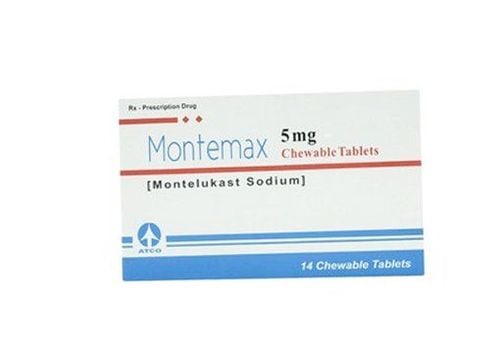This is an automatically translated article.
Asthmatin 5 drug has the main active ingredient Montelukast in the form of Montelukast sodium 5mg. This drug is used in the treatment of respiratory diseases, especially chronic asthma.
1. What is Asthmatin 5?
What is the drug Asthmatin 5? Asthmatin 5 has the main active ingredient Montelukast in the form of Montelukast sodium 5mg. This drug is used in the treatment of respiratory diseases, specifically chronic asthma.
The drug is prepared in the form of direct chewable tablets. Packing is a box of 3 blisters, each blister contains 10 tablets.
2. What diseases does Asthmatin 5 treat?
Asthmatin 5 is indicated for the adjuvant treatment of chronic asthma in people with moderate to mild asthma who have not responded well to inhaled corticosteroid therapy and indicated for the treatment of people for whom a rapid-acting β-agonist as needed has not responded well to asthma therapy. Asthmatin 5 helps relieve symptoms in people with seasonal allergic rhinitis. Asthmatin 5 is indicated for the prevention of symptoms of narrowing of the airways caused by exercise.
3. Usage and dosage of Asthmatin 5
3.1. How to take Asthmatin 5 Asthmatin 5 is prepared in the form of chewable tablets, suitable for oral use. The patient should chew the tablet whole while taking it.
3.2. Dosage of Asthmatin 5 Recommended therapeutic dose:
For people aged 15 years and older: dose is 1 tablet 10mg/day. For children from 6 to 14 years old: the dose is 1 tablet of 5mg/day. 3.3. You should continue taking Asthmatin 5 even if your asthma is under control and during more severe asthma episodes.
In the prophylactic dose: it is necessary to evaluate the results after 2 to 4 weeks of treatment. If medication does not respond satisfactorily, consider alternative or complementary treatments.
In adjunctive therapy: Bloktiene should not be abruptly replaced with inhaled corticosteroids.
To treat asthma, you should take Asthmatin 5 in the evening. With allergic rhinitis, the duration of medication depends on the needs of each specific case:
For people with both asthma and allergic rhinitis, it is recommended to take 1 tablet per day in the evening. For people 15 years of age and older with asthma and/or allergic rhinitis: 1 tablet of 10 mg or 2 tablets of 5 mg per day. For children 6 to 14 years of age with asthma and/or allergic rhinitis: 1 tablet of 5 mg daily. For children 2 to 5 years old with asthma and/or allergic rhinitis: 1 tablet 4 mg daily. For children 6 months to 2 years of age with asthma and/or year-round allergic rhinitis: 1 tablet 4 mg daily. 3.4. General recommendations The therapeutic effect of Asthmatin 5 on asthma test parameters is achieved within 1 day. It is recommended that patients continue to use Asthmatin 5, even if their asthma is under control, as well as during periods of more severe asthma. No dose adjustment is required for patients with renal impairment, mild and moderate hepatic impairment, the elderly, or for individual sex. Treatment in association with other asthma medications: Asthmatin 5 can be used in combination for people already on other treatment regimens. Reduce the dose of combination drugs: bronchodilators, inhaled or oral corticosteroids. Asthmatin 5 should not be abruptly replaced with inhaled or oral corticosteroids.
4. Undesirable effects of Asthmatin 5
During treatment with Asthmatin 5, some unwanted effects may appear, specifically as follows:
Nervous system disorders: Headache. Stomach and intestinal disorders: abdominal pain, diarrhea, dry mouth, indigestion, nausea, vomiting. Blood and lymphatic system disorders: increased risk of bleeding. Immune system disorders: hypersensitivity reactions including anaphylaxis, eosinophilic infiltration of the liver. Psychiatric disorders: dream abnormalities include: frequent nightmares, hallucinations, insomnia, irritability, anxiety, hyperactivity, agitation including aggressive behavior, tremor, depression. Nervous system disorders: dizziness, vertigo, somnolence, paresthesia/hypoesthesia or seizures. Cardiac disorders: increased palpitations, palpitations. Respiratory, thoracic and mediastinal disorders: Increased risk of nosebleeds. Liver and biliary disorders: Elevated serum transaminase levels, cholestatic hepatitis. Skin and subcutaneous tissue disorders: angioedema, bruising, urticaria, rash, rash, erythema nodosum. Musculoskeletal system disorders: joint pain, muscle fatigue including cramps. Systemic disorders and disorders at the site of use: Asthenia, fatigue, malaise, edema or fever.
5. Interactions of Asthmatin 5
Possible drug interactions of Asthmatin 5 are as follows:
Possible drug interactions are caused by the main active ingredient being metabolised by CYP3A4. Patients should exercise caution, especially in children, when montelukast is co-administered with CYP3A4 inducers such as Phenytoin Phenobarbital and Rifampicin. The active ingredient Montelukast can be used together with other commonly used drugs for the prevention and treatment of chronic asthma. In drug interaction studies, Montelukast had no significant effect on the pharmacokinetics of drugs such as Theophylline, Prednisone, Prednisolone, oral contraceptives (Ethinyl estradiol/norethindrone 35/1), Terfenadine, Digoxin and Warfarin . In vitro studies have shown that the main active ingredient Montelukast is an effective inhibitor of CYP 2C8.
6. Some notes when using the drug Asthmatin 5
6.1. Contraindications of Asthmatin 5 Asthmatin 5 is contraindicated for people with hypersensitivity to any ingredient of the drug.
6.2. Precautions for Asthmatin 5 Montelukast-containing medicines should not be used in the treatment of people with acute asthma attacks and in the stable maintenance of appropriate emergency treatment normally for those using the drug. for this purpose. Do not suddenly replace inhaled or oral corticosteroids with Asthmatin 5 . The safety and efficacy of Asthmatin 5 in children under 2 years of age have not been established. Asthmatin 5 contains Aspartame, a source of phenylalanine: Asthmatin 5 may be harmful to people with phenylketouria. For people with signs of galactose intolerance, Lapp lactase deficiency, glucose-galactose malabsorption: Asthmatin 5 should not be used. Use of drugs for pregnant women: Currently, it is not known whether Asthmatin 5 affects the fetus or not, so pregnant women only use it in cases where it is absolutely necessary. During the use of the drug, if you become pregnant, the patient should notify the treating doctor for appropriate treatment. Use in breast-feeding women: It is not known whether Asthmatin 5 is excreted in breast milk, so it should only be used when absolutely necessary. Use of drugs for driving and operating machines: Asthmatin 5 does not reduce the ability of users to drive and use machines. However, in some cases, Asthmatin 5 can cause drowsiness and dizziness. So when you use the drug, you need to be especially careful and careful when doing these activities. Above is all information about Asthmatin 5, patients need to carefully read the instructions for use, consult a doctor / pharmacist before using. Absolutely do not arbitrarily buy Asthmatin 5 treatment at home, because there may be unwanted side effects.
Follow Vinmec International General Hospital website to get more health, nutrition and beauty information to protect the health of yourself and your loved ones in your family.
Please dial HOTLINE for more information or register for an appointment HERE. Download MyVinmec app to make appointments faster and to manage your bookings easily.













